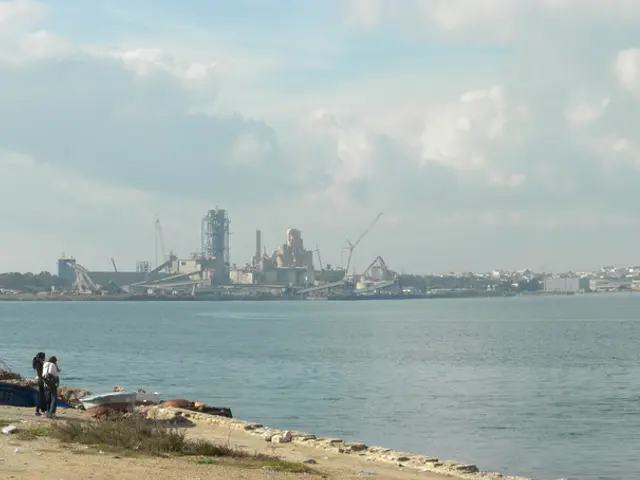Critical events during Trump's initial 100 days: Legal disputes, executive orders, cabinet appointments, and golf outings
In the whirlwind of his second term, President Donald Trump set out to dismantle the administrative state born under Franklin D. Roosevelt over 90 years ago. Flaunting an unprecedented strategy to demolish government, Trump enlisted none other than Elon Musk to pace this destruction at a startling rate.
Trump's daring moves to shrink government include cutting international and scientific research funding, firing federal workers, and implementing a sudden surge of executive orders that rival even the highest total signed by FDR in a single year. The President's flood-the-zone approach to major policy proposals has left Americans reeling – his mass deportations disrupt American neighborhoods, while his tariffs could potentially remake world trade.
This rat-a-tat approach has encountered resistance, as he exercises executive power in ways unimaginable by the framers of the Constitution, directly challenging portions of the Constitution itself. Trump also found time for multiple trips to his private Florida club in Mar-a-Lago but has seen his approval ratings slip in the process.
Here's a snapshot of Trump's first 100 days in his second term by some of the biggest numbers:
- No president other than FDR has signed more executive orders in a single year than Trump. These directives, along with executive actions, include consequential changes such as rescinding equal opportunity requirements in federal government hiring that date back 50 years; directing the US military to help at the border; and unwinding Biden administration efforts to combat climate change.
Other changes echo Trump's supporters' politics, such as declaring English the national language, trying to ban trans girls from girls' sports teams, and endorsing high-flow showers.
A drain on the federal workforce began immediately. Trump and Musk wasted no time in cutting down employment. Probationary workers who had recently joined agencies were fired; others were targeted by reductions in force and early retirement efforts. It's unclear how many workers Trump ultimately seeks to remove.
Trump's term has seen a decline in border encounters, thanks to the deployment of elements of the US military to the border and his aggressive deportation efforts. He has effectively shut the border to asylum seekers, bucking over 400 years of history.
His controversial efforts to rename the Gulf of Mexico as the Gulf of America have stirred controversy and court cases. His numerous trips to his private Florida club and his work from Mar-a-Lago have caused some dissonance with his insistence that federal workers must do their work from federal office buildings.
Trump has initiated a barrage of litigation to challenge the US Constitution, with ambitious plans to reinterpret the 14th Amendment, end birthright citizenship, and refuse to spend money appropriated by Congress. While these larger issues make their way to the Supreme Court, preliminary decisions have provided mixed results for Trump.
Trump has achieved remarkable success in confirming Cabinet secretaries, with all but one position filled. Thousands of lower positions remain unfilled, and Trump hopes to reclassify much of the bureaucracy to make it easier to dismiss or replace employees who don't support his agenda.
Trump's tariff policies, which include tariffs on imports from close US partners like Canada and Mexico, have caused market volatility, rising material costs, and plummeting consumer confidence. Simultaneously, tariffs delay reciprocal retaliation from other countries.
Despite the tariff-related economic challenges, Trump remains committed to this approach, promising to create new manufacturing jobs in the US and to combat a market flooded with Chinese goods, though economists have expressed doubt about the feasibility of adapting worldwide supply chains to a more nationalist approach.
Some impacts of the administration's actions on the tech sector, such as Tesla, remain unclear. However, CEO Elon Musk's close involvement with Trump's administration has polarized reforms, with Musk morphing from a climate change advocate to a top election benefactor for Trump, who denies the existence of climate change and prioritizes fossil fuel production.
Trump's interactions with international leaders, such as his confrontation with Ukrainian President Volodymyr Zelensky, have garnered significant attention. In their heated Oval Office meeting, Zelensky articulated a notable pushback to Trump's policy proposals, leaving the future of US-Ukraine relations uncertain.
- President Donald Trump, in his second term, aims to effectuate Roosevelt's administrative state destruction, enlisting Elon Musk to expedite the process.
- Trump's strategies for reducing government include reducing funding for international and scientific research, firing federal workers, and issuing a surge of executive orders that surpass FDR's total.
- Trump's rapid-fire approach to policy proposals has left the American public disoriented, with mass deportations disrupting communities and tariffs potentially reshaping global trade.
- Trump's presidency has faced opposition as he exercises executive power in ways the Constitution's framers never anticipated, directly questioning constitutional portions.
- The reduction of the federal workforce began immediately under Trump and Musk, with probationary workers being fired and others being targeted for layoffs and early retirement.
- Trump's term has resulted in a decline in border encounters due to the deployment of military personnel and aggressive deportation efforts, effectively deterring asylum seekers.
- Trump's administration has initiated numerous lawsuits to challenge the US Constitution, with plans to reinterpret the 14th Amendment, end birthright citizenship, and refusing to spend congressionally appropriated money.
- Trump's tariff policies, which include tariffs on imports from US allies like Canada and Mexico, have led to market volatility, increased material costs, and a decline in consumer confidence, while simultaneously delaying reciprocal retaliation from other countries. These policies have also caused ambiguity in their effect on the tech sector, such as Tesla, due to the close involvement of CEO, Elon Musk, with the administration.









